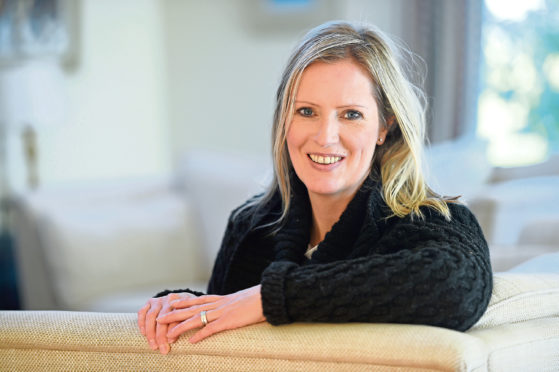Halloween was such an eventful time for us that we ended up skipping Bonfire Night altogether.
After the sugar-fuelled excitement of Halloween crafting and baking, guising, pumpkin carving fun and two lots of fun-filled spooky school discos, the girls (and I) were burned out by Guy Fawkes’ night, if you’ll pardon the pun.
October going into November has been an especially busy time here on the farm too.
The wet weather had Nick call on specialist help from Aberdeenshire in the shape of umbilical slurry company Sinclair Agricultural Contractors, which pump slurry directly to the field from the slurry store.
Not only does the smart system connect an ultra long hose from store to field, negating the use of heavy machinery on the already soft ground, but the dribble bar distributes the slurry very close to the soil, significantly reducing the lingering unpleasant odour for us and neighbours. The downside is the cost.
Usually the farm team spread the slurry themselves but the store was so full and the fields so wet that Nick had no choice. At least engaging contractors freed him and the staff up to prepare for the many farm visits we’ve had lately.
In the past three weeks alone we have welcomed a group from Ullapool High School, four classes from a local primary school – both organised and led by RHET Highland – as well as a group of 16 students from Queen Margaret’s College in Edinburgh, studying for an MA in Gastronomy.
The gastronomy students were on a whistle stop tour of several Black Isle food businesses. Coincidentally, one of the tutors is a former editor from my food journalism days, so the girls and I tagged along on this particular farm tour for a catch-up and because we hadn’t done one of daddy’s tours for a while.
The walk and talk usually begins outside the honesty shop and a general petting of the calves who live next to it before going on to the main cowshed in the middle of the farm.
Nick takes groups in through the old milking parlour, explaining the former twice-a-day hands-on milking, then into the shed itself to see the milking herd, deep sawdust bed cubicle system, the scrapers and the main event: the robotic milking.
Next is a visit to the dairy processing and production kitchen, where the milk is pasteurised and the yoghurt and ice cream are made before ending back at the honesty shop to see the milk vending machine in action.
Depending on the size of the group and the amount of questions asked, the tour usually takes around an hour and Nick, after initial nerves in the early days, has grown to enjoy these educational visits.
Somewhat less enjoyable, albeit necessary, were recent visits from farm assurance body Red Tractor, and Environmental Health, both conducting their annual routine inspections within a week of each other.
Happily, all went well.
Meanwhile inside the farmhouse, Nick has had me on admin duties – since getting the all-clear from the orthopaedic consultant last month, he’s retired me from ice cream deliveries – after our processing arm was nominated for a Scottish Rural Award.
The form, which asked all sorts of questions from why we diversified and what makes our products artisan to how our product has put the rural community on the map and what our business is doing to reduce our environmental impact, got me thinking about dairying both now and in the past. Call me old-fashioned, but it sometimes seems like we were more eco-friendly 30 years ago when there were electric milk floats, returnable glass bottles, and milk came naturally unhomogenised with cream at the top of the bottle.
Nick and I feel we are at least trying to get back to this more sustainable way of delivering milk and dairy products in our scattered rural settlement, especially since launching the milk vending in spring.
Thank goodness too for enterprising folk like Richard Jones and his visionary Farming Academy, Rootfield’s most recent visitors.
A community interest company, the Farmer Jones Academy was founded to address the skills shortage within the farming, food and drink sectors by offering practical training and development courses to secondary school pupils.
Taking over his father’s farm at a young age, Richard is a well-known farming journalist and broadcaster and now offers a foundation apprenticeship course in food and drink technologies (equivalent to two national higher qualifications) through his academy.
A small group of 5th and 6th year pupils from Fortrose Academy taking the course came to the farm earlier this week to do the tour with field trips to farms and food-related businesses, like ours, as well as talks and demonstrations by entrepreneurs as part of the course.
The participating students get to take a product from concept to implementation, learning industry skills such as marketing, research and development along the way as well as gaining an understanding of strategic planning, logistics, distribution and experience of different media outlets and e-commerce.
I’m amazed and heartened by what’s on offer for people in education today. The apprenticeship sounds highly vocational, well-rounded and challenging: one we’d be delighted for either of our girls to study. And if the masters in gastronomy had been around 20 years ago, I’d have applied for it.
l NEXT MONTH: It’s Christmas….!
Rootfield Farm is on the Black Isle, 10 miles north of Inverness, where Jo lives with husband Nick, a dairy farmer, their daughters Daisy and Mollie, and 170 cows
